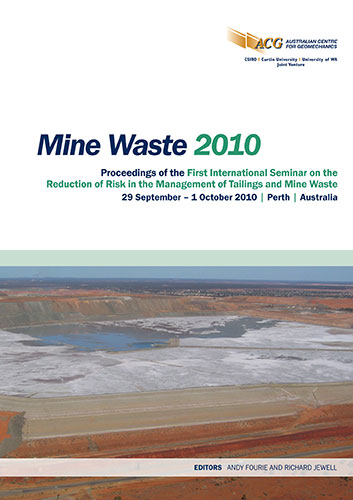Environmental risk mitigation through concurrent disposal of tailings and mine waste rock at the Minago project in north-central Manitoba, Canada

|
Authors: Zivkovic, A; Mchaina, D; Henderson, M; Matich, MAJ Paper is not available for download Contact Us |
DOI https://doi.org/10.36487/ACG_rep/1008_35_Zivkovic
Cite As:
Zivkovic, A, Mchaina, D, Henderson, M & Matich, MAJ 2010, 'Environmental risk mitigation through concurrent disposal of tailings and mine waste rock at the Minago project in north-central Manitoba, Canada', in R Jewell & AB Fourie (eds), Mine Waste 2010: Proceedings of the First International Seminar on the Reduction of Risk in the Management of Tailings and Mine Waste, Australian Centre for Geomechanics, Perth, pp. 417-430, https://doi.org/10.36487/ACG_rep/1008_35_Zivkovic
Abstract:
The Minago Project, owned by Victory Nickel, is located in the north-central part of the Province of Manitoba, Canada. The site is perennially flooded and is covered with peat (muskeg), which overlies a variable thickness of hard and then soft clay underlain by dolomite bedrock. The site climate is characterised by warm wet summers, and cold and dry winters. The project, which is completed to the feasibility level design, will comprise of an open pit mine producing nickel ore, frac sand, dolomite, granitic rock, and ultramafic waste rock. The leachates from the dolomite and the granitic rock units are not expected to raise any environmental concerns with respect to acid rock drainage and metal leaching (ard/ml). however, ultramafic units are considered as potentially acid generating and metal leaching (PAG/ML). During initial studies of on-land disposal, three separate waste rock dumps for the ultramafic, granite and dolomite waste rock were considered. The ultramafic waste rock dump included a perimeter effluent collection system and post closure treatment in-perpetuity. This was not acceptable to the company and as such a new approach was required. The key objective of subsequent approach was to mitigate environmental risks related to the disposal of PAG/ML ultramafic waste rock. To meet this objective, a tailings and waste rock management facility (TWRMF) was developed to encapsulate the PAG/ML ultramafic waste rock with tailings in a single repository using a novel concurrent disposal approach. A review of published precedents for co-disposal of waste rock and tailings was carried out. Although a number of studies including laboratory/field-scale tests have been described in the literature, the results of the review confirmed a lack of direct precedent for efficient long-term co-disposal applicable to the Minago site-specific conditions. The development of the TWRMF disposal scheme draws upon selected components of precedents from the authors’ experience. It is supported by analyses required to confirm technical feasibility. There will be an emphasis on optimisation during detailed design and operational planning. Mitigation of environmental risks will be achieved by minimising ARD/ML potential by partially submerging the waste rock during operation, ultimately achieving full submergence of a combined waste rock and tailings mass, and controlling seepage to tolerable limits in the long-term. Field trials and a comprehensive instrumentation and monitoring program are planned. This paper focuses mainly on the environmental issues involved and the selected disposal scheme.
References:
Canadian Dam Association (CDA) (2007) Dam Safety Guidelines, Canadian Dam Association.
Environment Canada (2002) Metal Mining Effluent Regulations, SOR/202-222, June 6, 2002, Canada, Gazette Part II,
Vol. 136, No. 13.
GeoStudioTM (2007), GEO-SLOPE International Ltd, Calgary, Alberta, Canada.
Golder Associates (2009) Hydrologic Baseline Study - Minago Project, Manitoba, Prepared for Victory Nickel, Inc., dated
January 22, 2009, Report 08-1428-0024).
James, M. and Aubertin, M. (2009) The Use of Waste Rock Inclusions in Tailings Impoundments to Improve Geotechnical
and Environmental Performance, Tailings and Mine Waste 2009, Alberta, Canada.
Jennings, M.T. and Matich, M.A.J. (1981) Expansion of Algoma Ore Division’s Tailings Impoundment Area at Wawa,
Joint Annual Conference, Air Pollution Control Association, Ontario Section and Pollution Control Association of
Ontario, Canada.
Leduc, M., Bachens, M. and Smith, M.E. (2004) Tailings Co-DisposalTM in Sustainable Development, in Proceedings
annual meeting of the Society for Mining, Metals and Exploration, SME, Denver, February, 2004 and ‘Safer,
Cleaner, and Potentially Cost-Effective,’ Mining Environmental Management magazine, March, 2004.
McRoberts, E.C. and Prochera, R. (1986) Dredged Slopes at Thompson Open Pit, Canadian Geotechnical Journal, Vol. 23.
Morawski, F.P., Jeffries, J.D., Wilson, D.M., Schelske, J.E., Geddes, J.R. and Eberts, B.R. (1970) The Griffith Mine Story,
CIM Bulletin, November, 1970.
Murray, L., Thompson, M. and Lane, M. (2003) Obstacles to On-Land Mine Tailings Disposal in Papua New Guinea,
ICOLD 2003, Montreal, June 2003.
Romano, C., Zawadski, W., Chorley, D.W., Neuner, M. and Mchaina, D.M. (2009) Design of an Open Pit Dewatering
System – Minago project, Grand Rapids, Manitoba, 62nd Canadian Geotechnical Conference and 10th Joint
CGS/IAH-CNC Groundwater Conference, September 20–24, 2009.
URS (2009) Final Report: Geochemical (ARD/ML) Assessment, Minago Project near Grand Rapids, Manitoba, December
9, 2009.
Victory Nickel Inc. (2010) Minago Project, Environmental Impact Statement, Environment Act Proposal: Volumes I, II
and III, April 30, 2010.
Wardrop Engineering Inc. (2010) Victory Nickel Inc: Minago Feasibility Study, March, 2010.
Whitman, E.W., Reipas, S.A. and Hardy, R.M. (1963) Unusual Problems in the Development of the Caland Mining
Operation at Steep Rock Lake, Engineering Institute of Canada, Vol. 1, No. 27.
Wickland, B. and Wilson, G.W. (2005a) Research of Co-Disposal of Tailings and Waste Rock, Geotechnical News,
September, 2005.
Wickland, B.E. and Wilson, G.W. (2005b) Self-Weight Consolidation of Mixtures of Mine Waste Rock and Tailings,
Canadian Geotechnical Journal, Vol. 42.
Wilson, G.W. (2000) Embankment Hydrology and Unsaturated Flow in Waste Rock, Slope Stability in Surface Mining,
W.A. Hustrulid, M.K. McCarter and D.J.A. Van Zyl (eds), Society for Mining, Metallurgy, and Exploration, Inc.
Wislesky, I. (2004) Blast Densification of Hydraulically Placed, Loose, Saturated and Stratified Mine Tailings, Tailings
and Mine Waste 2004, Taylor & Francis Group, London, pp. 331–346.
© Copyright 2025, Australian Centre for Geomechanics (ACG), The University of Western Australia. All rights reserved.
View copyright/legal information
Please direct any queries or error reports to repository-acg@uwa.edu.au
View copyright/legal information
Please direct any queries or error reports to repository-acg@uwa.edu.au